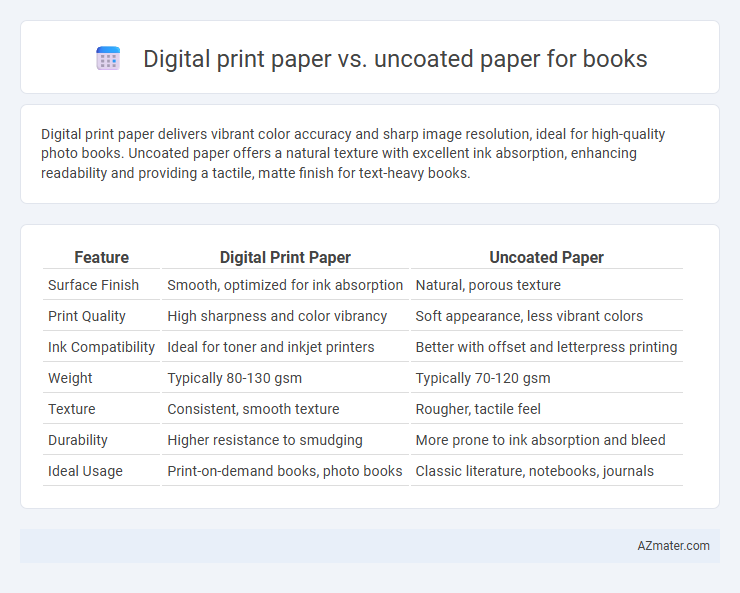Digital print paper delivers vibrant color accuracy and sharp image resolution, ideal for high-quality photo books. Uncoated paper offers a natural texture with excellent ink absorption, enhancing readability and providing a tactile, matte finish for text-heavy books.
Table of Comparison
| Feature | Digital Print Paper | Uncoated Paper |
|---|---|---|
| Surface Finish | Smooth, optimized for ink absorption | Natural, porous texture |
| Print Quality | High sharpness and color vibrancy | Soft appearance, less vibrant colors |
| Ink Compatibility | Ideal for toner and inkjet printers | Better with offset and letterpress printing |
| Weight | Typically 80-130 gsm | Typically 70-120 gsm |
| Texture | Consistent, smooth texture | Rougher, tactile feel |
| Durability | Higher resistance to smudging | More prone to ink absorption and bleed |
| Ideal Usage | Print-on-demand books, photo books | Classic literature, notebooks, journals |
Understanding Digital Print Paper
Digital print paper is specially engineered to absorb toner or inkjet ink efficiently, ensuring sharp images and vibrant colors in short-run or on-demand book printing. Its smooth surface and optimized coatings prevent ink bleed, allowing for precise text and graphic reproduction compared to uncoated paper, which often results in blurrier prints due to ink absorption. Digital print paper's compatibility with advanced digital presses makes it ideal for high-quality book production with consistent color fidelity and faster turnaround times.
What Is Uncoated Paper?
Uncoated paper refers to paper that lacks a glossy or matte finish, providing a natural, porous surface ideal for absorbing ink and producing crisp, clear text. It is typically used in book printing for its tactile feel, durability, and excellent readability, especially for novels and text-heavy publications. Compared to digital print paper, uncoated paper offers a more traditional appearance and better writing surface, making it a preferred choice for many book publishers.
Key Differences Between Digital Print and Uncoated Paper
Digital print paper features a smooth, coated surface that enhances ink absorption and sharp image reproduction, making it ideal for vibrant, high-resolution book interiors. Uncoated paper offers a more natural, matte finish with increased texture, which leads to softer ink absorption and a tactile reading experience but may result in less vivid color output. Choosing between digital print paper and uncoated paper depends on the desired visual impact and tactile quality for books, balancing color vibrancy against natural feel.
Print Quality: Digital vs. Uncoated Paper
Digital print paper offers vibrant, sharp, and consistent print quality ideal for high-resolution images and text, enhancing visual appeal and readability in books. Uncoated paper tends to absorb more ink, resulting in softer, more muted colors and a natural, tactile feel that suits artistic and vintage-style publications. The choice between digital print and uncoated paper impacts color accuracy, sharpness, and overall presentation, influencing the reader's engagement and perception of the book.
Texture and Feel: Choosing the Right Paper for Readers
Digital print paper offers a smooth, uniform texture ideal for vibrant color reproduction and sharp text clarity, enhancing the visual experience for readers. Uncoated paper provides a natural, tactile feel with a slight roughness that reduces glare, making it comfortable for extended reading sessions. Selecting between digital print and uncoated paper impacts the reader's sensory engagement and should align with the book's purpose and target audience preferences.
Durability and Longevity in Book Publishing
Digital print paper typically offers higher durability and resistance to wear due to its smooth, coated surface that repels dirt and moisture, making it suitable for short-run book publishing. Uncoated paper, preferred for its natural texture and superior ink absorption, tends to be less durable and more prone to yellowing and damage over time, affecting the longevity of books. For long-term preservation and archival quality in book publishing, uncoated papers with acid-free or archival grades are often favored despite their lower resistance to physical wear.
Cost Comparison: Digital Print Paper vs. Uncoated Paper
Digital print paper typically incurs higher initial costs due to advanced coatings and compatibility with digital printers, but it reduces waste and setup expenses in short runs, making it cost-effective for small to medium volumes. Uncoated paper is generally less expensive per sheet and preferred for large print runs, but it may require additional finishing or coating to achieve desired print quality, increasing overall costs. Evaluating print volume and quality requirements is essential for optimized budgeting between digital print paper and uncoated paper options.
Environmental Impact and Sustainability
Digital print paper often uses recycled fibers and environmentally friendly inks, reducing waste and supporting sustainable printing practices, while uncoated paper is typically more biodegradable and easier to recycle due to the absence of chemical coatings. Uncoated paper production generally consumes less energy and water, lowering its overall environmental footprint compared to coated options often used in digital printing. Choosing either paper depends on the balance between print quality needs and commitment to minimizing carbon emissions and resource consumption.
Best Applications for Each Paper Type
Digital print paper excels in short-run book printing and on-demand publishing due to its compatibility with laser and inkjet printers, delivering sharp images and vibrant color reproduction ideal for photo books, manuals, and marketing materials. Uncoated paper is preferred for novels, textbooks, and notebooks where readability, ease of annotation, and a tactile, matte finish are valued, providing a natural feel that reduces glare and enhances prolonged reading comfort. Each paper type suits specific book applications by balancing print quality, texture, and user experience requirements for targeted publication needs.
Expert Recommendations for Book Printing
Experts recommend digital print paper for short-run book printing due to its consistent quality, smooth surface, and excellent ink absorption, which enhances image sharpness and color vibrancy. Uncoated paper is preferred for books requiring a natural, tactile feel, offering a matte finish ideal for text-heavy content and reducing glare for easier reading. For optimal results, choose digital print paper when vivid visuals are essential and uncoated paper for traditional, easy-to-read literary works.

Infographic: Digital print paper vs Uncoated paper for Book
 azmater.com
azmater.com